Table of Contents
ToggleIn today’s fast-paced business environment, agility has become a cornerstone for organizations looking to thrive. Companies are constantly on the lookout for frameworks that can help them adapt quickly to changes, deliver value consistently, and remain competitive. The Scaled Agile Framework® (SAFe®) is one such approach that provides a comprehensive solution for large enterprises aiming to achieve business agility. In this deep dive, we’ll explore what SAFe® is, how it fosters business agility, and why mastering it is crucial for organizations today.
What is Business Agility?
Business agility is the ability of an organization to quickly respond to changes in the market and customer needs while ensuring high-quality delivery of products and services. It requires flexibility, speed, and a shift in mindset, allowing teams to pivot based on new information and feedback. Organizations that excel in business agility can capitalize on new opportunities, mitigate risks, and continuously improve their processes.
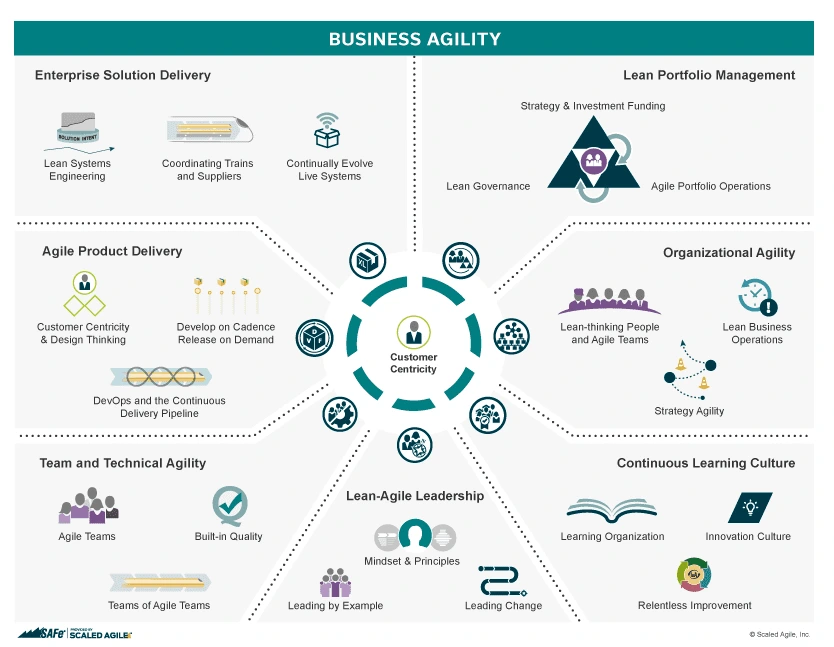
In a rapidly changing environment, business agility enables companies to align their strategic goals with customer demands, all while fostering a culture of innovation and collaboration. It’s about creating an organization that not only survives but thrives amidst constant change.
Introduction to SAFe®
The Scaled Agile Framework® (SAFe®) is a framework that allows large enterprises to adopt Agile principles and methodologies at scale. SAFe® provides a structured approach for aligning Agile teams across an organization, ensuring continuous value delivery, and enhancing business agility.
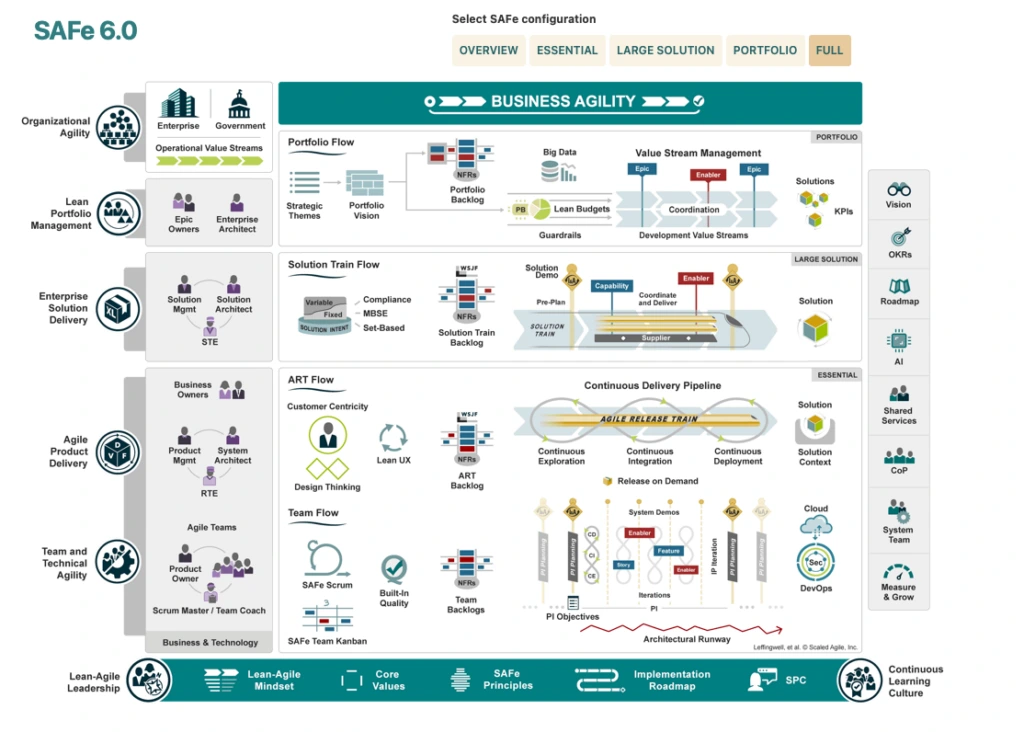
Originally developed by Dean Leffingwell, SAFe® addresses the complexities of scaling Agile by providing guidelines, principles, and practices that integrate Lean, Agile, and DevOps at an enterprise level. By using SAFe®, organizations can synchronize the work of multiple Agile teams, enabling them to work cohesively towards common goals.
The Core Values of SAFe®
At the heart of SAFe® are four core values that drive its success:
a. Alignment: SAFe® ensures that all teams within an organization are aligned to a common vision and strategy. This is essential for large enterprises where numerous Agile teams work concurrently on different projects.
b. Built-in Quality: Quality is a non-negotiable aspect of SAFe®. It ensures that teams deliver products and services that meet the highest standards, eliminating defects early in the process.
c. Transparency: SAFe® promotes openness and visibility across all teams. This allows for honest assessments, faster problem-solving, and better decision-making.
d. Program Execution: SAFe® focuses on delivering value through successful execution at all levels. Teams work in sync to ensure that business objectives are met and that customer needs are addressed.
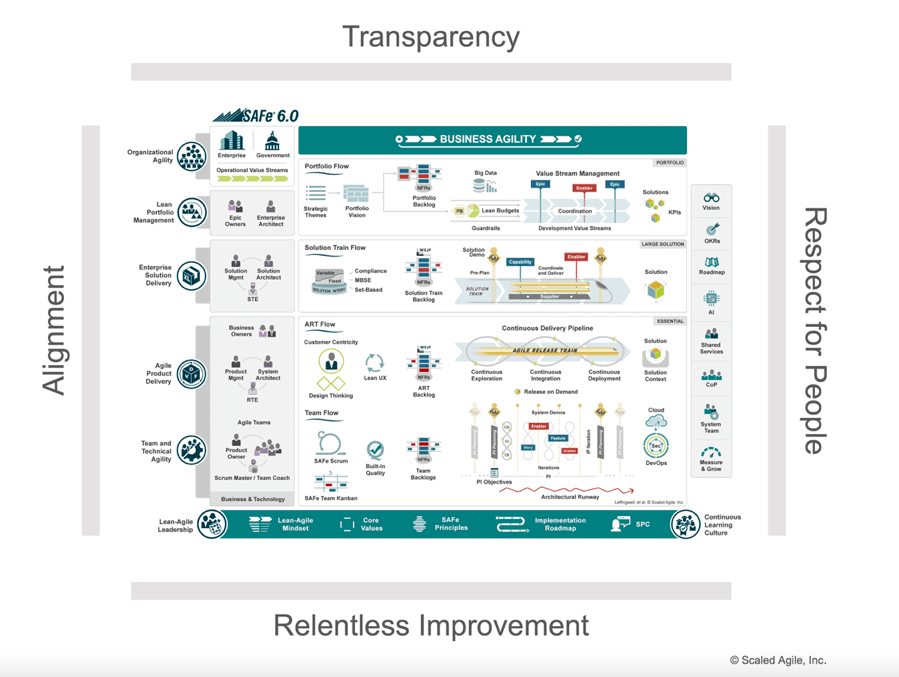
The SAFe® Framework: Key Components
The SAFe® framework is composed of several critical layers that work together to drive business agility:
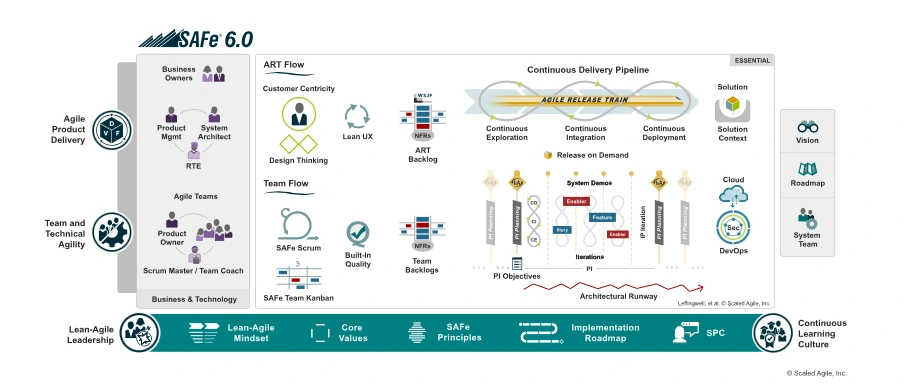
a. Team Level
At the team level, SAFe® encourages the use of Agile practices such as Scrum and Kanban. Teams work in short iterations, known as sprints, and deliver working software or products at the end of each sprint.
b. Program Level
The program level focuses on coordinating the work of multiple Agile teams, known as an Agile Release Train (ART). ARTs are the heartbeat of SAFe®, delivering incremental value in the form of Program Increments (PIs), which typically last 8 to 12 weeks.
c. Portfolio Level
At the portfolio level, SAFe® connects the strategic vision of the organization with the execution of Agile teams. It ensures that business objectives and initiatives are aligned with the work being done at the program and team levels.
d. Value Stream Level
Value streams represent the end-to-end processes within the organization that deliver value to customers. SAFe® ensures that each value stream is optimized to deliver maximum value in the shortest amount of time.
The Benefits of Implementing SAFe®
Over 1 million professionals across 20,000 organizations worldwide have recognized the advantages of scaling agile using SAFe.
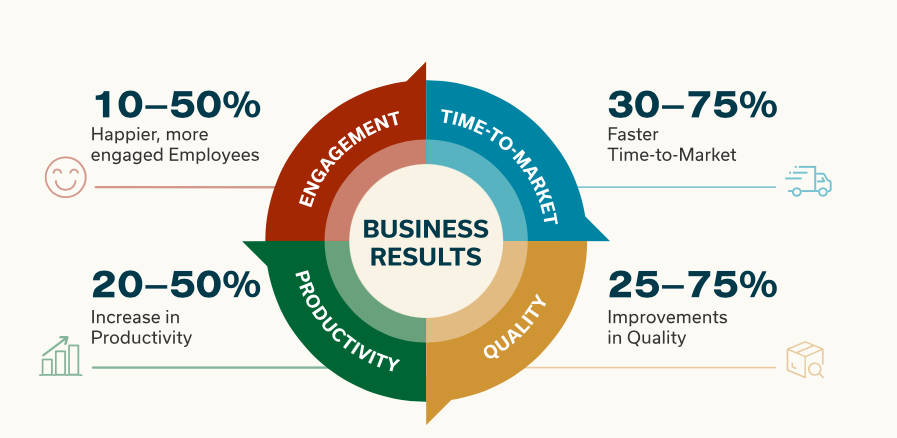
a. Enhanced Collaboration and Alignment
By implementing SAFe®, organizations can break down silos and encourage cross-functional collaboration. This alignment ensures that all teams are working towards a shared vision, leading to more cohesive and effective project delivery.
b. Faster Time-to-Market
SAFe® promotes continuous delivery, which helps organizations release products and services more frequently. This faster time-to-market enables companies to stay ahead of their competition and respond quickly to customer demands.
c. Improved Quality and Efficiency
The built-in quality aspect of SAFe® ensures that products are free of defects and meet customer expectations. Moreover, SAFe® encourages continuous improvement, leading to more efficient processes and better use of resources.
d. Scalability Across Teams and Portfolios
One of the key strengths of SAFe® is its ability to scale Agile practices across multiple teams, programs, and portfolios. This scalability allows large enterprises to manage complex projects with ease.
Real-World Examples of SAFe® in Action
a. Cisco
Cisco implemented SAFe® to streamline its processes across various teams. By adopting SAFe®, they were able to reduce time-to-market for their products and enhance collaboration among different departments. This led to higher customer satisfaction and improved product quality.
b. Fitbit
Fitbit leveraged SAFe® to scale its Agile practices across multiple teams. This enabled them to launch new features and updates faster, improving customer engagement and satisfaction.
c. LEGO Group
The LEGO Group adopted SAFe® to enhance its IT operations. By using SAFe®, they achieved better alignment between business units and IT teams, leading to faster delivery times and more innovative solutions.
Common Challenges and Solutions in SAFe® Adoption
Despite its benefits, implementing SAFe® can come with certain challenges. Some of the most common include:
a. Resistance to Change
Change is often met with resistance, and implementing SAFe® is no different. To overcome this, organizations should provide adequate training and emphasize the long-term benefits of adopting SAFe®.
b. Lack of Agile Experience
SAFe® requires a certain level of Agile maturity. Organizations that lack experience with Agile may struggle with SAFe® adoption. In such cases, it’s important to start small, with pilot projects, before scaling Agile across the organization.
c. Difficulty in Scaling
Scaling Agile practices across large organizations can be complex. It’s important to have strong leadership and a clear vision to ensure successful SAFe® implementation.
SAFe® Certifications: Elevating Your Skills in Agile
To master SAFe®, professionals can pursue various SAFe® certifications that provide in-depth knowledge and skills. Some of the most sought-after certifications include:
- SAFe® Agilist (SA): Ideal for those leading the Lean-Agile transformation within their organizations.
- SAFe® Scrum Master (SSM): Focuses on Scrum practices within the SAFe® framework.
- SAFe® Product Owner/Product Manager (POPM): Tailored for those managing the product development process.
These certifications not only boost individual career prospects but also contribute to the overall success of Agile transformation within organizations.
How to Master Business Agility with SAFe®
Mastering business agility with SAFe® requires a strategic approach:
- Invest in Training: Ensure your teams are well-trained in SAFe® practices and principles.
- Start with a Pilot: Implement SAFe® on a smaller scale before expanding it across the organization.
- Foster a Lean-Agile Mindset: Encourage teams to embrace a Lean-Agile mindset, focusing on continuous improvement and collaboration.
- Use Metrics to Measure Success: Regularly track progress using Agile metrics, such as velocity, lead time, and customer satisfaction.
Conclusion: Embracing Business Agility for Future Success
In conclusion, mastering business agility with SAFe® is a transformative journey that requires commitment, collaboration, and continuous learning. By adopting SAFe®, organizations can survive in today’s competitive landscape and thrive by delivering consistent value, fostering innovation, and responding quickly to change.
SAFe® is more than just a framework—it’s a mindset that enables organizations to achieve true business agility and ensure long-term success.
